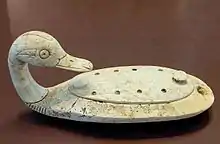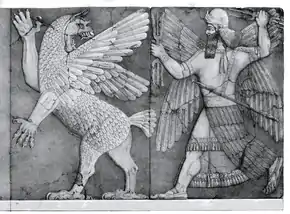Legend of Keret
The Legend of Keret, also known as the Epic of Kirta, is an ancient Ugaritic epic poem,[1][2] dated to Late Bronze Age, circa 1500 – 1200 BC.[3] It recounts the myth of King Keret of Hubur. It is one of the Ugarit texts.
| Ugarit |
|---|
 |
| Places |
| Kings |
| Culture |
| Texts |
| Part of a series on |
| Ancient Mesopotamian religion |
|---|
 Chaos Monster and Sun God |
| Related topics |
History
The epic story of Keret is contained in three rectangular clay tablets, excavated by a team of French archaeologists in Ugarit (modern Ras Shamra), Syria in 1930–31.[4] The text is written in the Ugaritic cuneiform script. (While this script looks superficially similar to Mesopotamian cuneiform, there's no direct relationship between them.) Not all of the tablets recovered were well-preserved and some of the tablets, containing the ending of the story, appeared to be missing. The tablets were inscribed by Ilimilku, a high priest who was also the scribe for the Myth of Baal (a part of the Baal cycle) and the Legend of Aqhat, two other famous Ugaritic epic poems discovered at the Ras Shamra site.[5]
The initial French translation of the tablets was published by a French archaeologist Charles Virolleaud, in a 1936 monograph[6] and then in the journal Syria. A substantial number of other translations, in many languages, appeared afterwards. Among them the translations of Ginsberg (1946)[7] and Herdner (1963)[8] are widely used. Some of the more modern translations include Gordon (1977),[9] Gibson (1978),[10] Coogan (1978),[11] and Greenstein (1997).[12]
The Keret tablets are held at the Musée National d'Alep, Syria.[13]
Story of Keret described in the tablets
King Keret of Hubur (or Khuburu), despite being reputed to be a son of the great god El himself, was struck with many misfortunes. Although Keret had seven wives, they all either died in childbirth or of various diseases or deserted him, and Keret had no surviving children. While his mother had eight sons, Keret was the only one to survive and he had no family members to succeed him and saw his dynasty in ruin.
Keret prayed and lamented his plight. In his sleep, the god El appeared to Keret, who begged him for an heir. El told Keret that he should make war against the kingdom of Udum and demand that the daughter of King Pubala of Udum be given to him as a wife, refusing offers of silver and gold as a price of peace.
Keret followed El's advice and set out for Udum with a great army. Along the way he stopped at a shrine of Athirat, the goddess of the sea, and prayed to her, promising to give her a great tribute in gold and silver if his mission succeeded.
Keret then lay siege to Udum and eventually prevailed and forced King Pubala to give his daughter (in some translations, granddaughter), Hariya, to Keret in marriage. Keret and Hariya were married and she bore him two sons and six daughters. However, Keret reneged on his promise to the goddess Athirat to pay her a gold and silver tribute after his marriage.
[At this point there is a break in the story due to damage to the tablets]. When the story resumes, Keret's children are grown up.
The goddess Athirat grew angry at Keret's broken promise and struck him with a deadly illness. Keret's family wept and prayed for him. His youngest son, Elhu, complained that a man, who was said to be the son of the great god El himself, should not be allowed to die. Keret asked for only his daughter, Tatmanat, whose passion was the strongest, to pray to the gods for him. As Tatmanat prayed and wailed, the land first grew dry and barren but eventually was watered by a great rain.
At the time the gods were debating Keret's fate. Upon learning of Keret's broken promise to Athirat, El took Keret's side and said that Keret's vow was unreasonable and that Keret should not be held to it. El then asked if any of the other gods could cure Keret, but none were willing to do so. Then El performed some divine magic himself and created a winged woman, Shatiqtu, with the power to heal Keret. Shatiqtu cooled Keret's fever and cured him of his sickness. In two days Keret recovered and resumed his throne.
Then Yassub, Keret's oldest son, approached Keret and accused him of being lazy and unworthy of the throne and demanded that Keret abdicate. Keret grew angry and cast a terrible curse on Yassub, asking Horonu, the master of demons, to smash Yassub's skull.
At this point the story breaks and the ending of the text appears to be missing. While the end of the legend is unknown, many scholars assume that afterwards Keret lost all of his children, except for one daughter, who became his sole heir.[14]
Study and interpretation
Since its discovery in early 1930s, the Legend of Keret has been the subject of active scholarly study and gave rise to a wide variety of (often conflicting) analogies and interpretations.[15] Most scholars agree that Keret is a purely mythical figure, although it is possible that some individual aspects of the myth do have historical basis.[16] Cyrus H. Gordon argued, "It anticipates the Helen-of-Troy motif in the Iliad and Genesis, thus bridging the gap between the two literatures."[17] Apart from the scholarly research in ancient literary traditions, the epic of Keret is frequently discussed in biblical studies and in the study of history of religion.
See also
- Ugarit
- Ancient Semitic religion
- Canaanite religion
- Translation
- Poetry
References
- Samuel Henry Hooke. Middle Eastern Mythology. Dover Publications, 2004. ISBN 978-0-486-43551-0; pages 87–89.
- Cyrus H. Gordon. Notes on the Legend of Keret. Journal of Near Eastern Studies, Vol. 11, No. 3 (Jul., 1952), pp. 212–213.
- Baruch Margalit. The Legend of Keret. In: Wilfred G. E. Watson, and Nicolas Wyatt (editors). Handbook of Ugaritic Studies. Brill Academic Publishers. 1999. ISBN 978-90-04-10988-9; Quote from page 203:"The poem of Keret is one of the three major literary works which gifted Canaanite poets of the Late Bronze Age (ca. 1500–1200 BCE) bequeathed serendipitously to 20th century civilization."
- Baruch Margalit. The Legend of Keret. In: Wilfred G. E. Watson, and Nicolas Wyatt (editors). Handbook of Ugaritic Studies. Brill Academic Publishers. 1999. ISBN 978-90-04-10988-9; pages 203–233.
- Johannes Cornelis de Moor. An Anthology of Religious Texts from Ugarit. E.J. Brill, 1987. ISBN 90-04-08330-8; page 224.
- C. Virolleaud. La Ligende de Keret, roi des sidoniens. P. Geuthner. Paris, 1936; OCLC: 2760369.
- Harold Louis Ginsberg. The legend of King Keret; a Canaanite epic of the bronze age. American Schools of Oriental Research, New Haven, Conn., 1946; OCLC: 757455
- Andrée Herdner. Corpus des tablettes en cuneiformes alphabétiques découvertes à Ras Shamra-Ugarit de 1929 à 1939. P. Geuthner. Paris, 1963; OCLC: 1399372
- Cyrus H. Gordon. "Poetic Legends and Myths from Ugarit." Berytus, vol. 25 (1977) pp. 5–133. [34–59]
- J. C. L. Gibson, Canaanite Myths and Legends. 2d ed. T. & T. Clark, Edinburgh, 1978; ISBN 0-567-02351-6
- Michael David Coogan, Stories from Ancient Canaan, Philadelphia: Westminster Press, 1978; ISBN 0-664-24184-0
- Edward L. Greenstein. "Kirta." In: Ugaritic Narrative Poetry, edited by S. B. Parker, pp. 9–48. Writings from the Ancient World 9. Atlanta: Scholars, 1997; ISBN 978-0-7885-0337-5
- Manfried Dietrich, Oswald Loretz, Joaquín Sanmartín. The Cuneiform Alphabetic Texts: From Ugarit, Ras Ibn Hani and Other Places (KTU: second, enlarged edition). Ugarit-Verlag, Münster. 1995. ISBN 3-927120-24-3, ISBN 978-3-927120-24-2; pp. 36–46 (tablets KTU 1.14–1.16).
- Johannes Cornelis de Moor. An Anthology of Religious Texts from Ugarit. E.J. Brill, 1987. ISBN 90-04-08330-8; page 191.
- Baruch Margalit. The Legend of Keret. In: Wilfred G. E. Watson, and Nicolas Wyatt (editors). Handbook of Ugaritic Studies. Brill Academic Publishers. 1999. ISBN 978-90-04-10988-9; pages 204-218: Section 2.2: The history of (mis)interpretation.
- Samuel Henry Hooke. Middle Eastern Mythology. Dover Publications, 2004. ISBN 978-0-486-43551-0; pages 87-89. Quote from page 89: "Some substratum of historical tradition may underlie this curious legend, but it is clear that it is mainly mythological, and some parts of it suggest connection with ritual.
- Cyrus H. Gordon, The Common Background of Greek and Hebrew Civilizations (1965)
External links
- The Epic of Keret, at www.kchanson.com